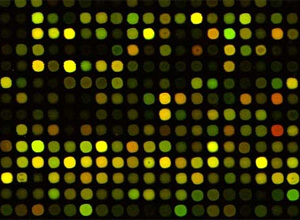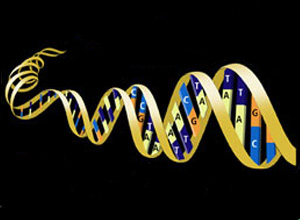This page has been archived and is no longer updated

In a 1944 groundbreaking experiment, Oswald Avery, Colin MacLeod, and Maclyn McCarty, researchers at the Rockefeller Institute for Medical Research, demonstrated that DNA is the molecule responsible for the inheritance of traits in living organisms. Their discovery launched intense worldwide investigation into this complex molecule, but even decades later DNA remained fundamentally undecipherable. Although scientists knew that the order of adenine, thymine, guanine, and cytosine (A, T, G, and C) nucleotides in strands of DNA somehow determined the characteristics of organisms, they were not able to resolve the sequence of these nucleotides in particular pieces of DNA. As a result, scientists could not establish the relationship between gene sequences and their consequences.
This situation changed in the mid-1960s, when the combined work of Francis Crick, Sydney Brenner, Marshall Nirenberg, Philip Leder, and Heinrich Matthaei revealed that individual amino acids are coded by three bases of DNA, a biochemical phenomenon later known as the genetic code. Knowing the relationship between DNA and amino acids changed everything and allowed scientists to see the connection between genes and the basic building blocks for all organisms. A decade later, Walter Gilbert and Allan Maxam as well as a separate team of scientists led by Frederick Sanger independently developed techniques to read the nucleotide sequences of DNA molecules. Researchers then began sequencing genes in a variety of organisms, hoping to understand the relationships between genetic codes and their effect. The longterm goal for many of these researchers was to identify specific patterns of DNA sequences that predispose humans to major diseases; these sequences could be parts of genes or several genes. However, the process of both sequencing genes and identifying their locations on chromosomes was manual and laborious, and in the 1970s, fully analyzing the genome of even a tiny microbe or virus seemed a formidable challenge for the community. In 1977, Sanger and his colleagues successfully sequenced the first full DNA genome, the 5,375-nucleotide-long sequence of the phi X174 bacteriophage.
As significant a milestone as this work was, sequencing the 3.2 billion base
pairs of the human genome still seemed nearly unthinkable. In 1983, however,
researchers at the California Institute of Technology funded by Applied
Biosystems used fluorescent tags and computer technologies to develop a
technique to automate Sanger's DNA sequencing technique. This advance made the
dream of sequencing the entire human genome achievable, and a scientific race
had begun. One group of researchers (later known as the International Human
Genome Sequencing Consortium) won funding from the US Department of Energy and
the National Institutes of Health in 1990 to initiate the Human Genome Project,
intending to sequence the entire human genome by 2005. In 1998, Celera
Genomics, a private company in Rockville,
Maryland, launched a parallel effort.
The competition between the publicly funded and the private efforts led to a
tie at the finish line in 2000 when the two groups announced completed drafts
of the human genome sequence at a televised White House press conference
attended by both US President Bill Clinton and UK Prime Minister Tony Blair. By
2003, when the Human Genome Project was completed, the researchers had
successfully sequenced nearly the entire the human genome with 99.99% accuracy.
To this day, many millions of bases that were considered noncoding or "junk"
DNA still await sequencing, and there is debate about the significance of these
remaining non-decoded sequences.
Alongside the high-profile quest to sequence the human genome, many scientists also set out to decode the genomes of rice, fruit flies, E. coli, chicken, mice, and hundreds of other organisms. The enormous amount of data this research has produced has given rise to the new and growing field of genomics: the quest to analyze and interpret genetic data to better understand genetic variation between individuals and different species, develop new treatments for major diseases, and understand human biology. In this Spotlight, we invite you to explore the history and present-day outlook of this revolutionary field.
--Ingrid Lobo, Ph.D.
Image: Courtesy of Dr. Doil Choi, CALS, Seoul National University.
Take a guided and interactive tour of your genome at DNA Interactive.
What were the goals and methods of the Human Genome Project?
Download a free iPad app with reflections on the human genome at 10.
How do scientists rapidly scan through entire genomes to detect genetic disorders and imbalances?
Discover how scientists designed and manufactured a genome from scratch to create a synthetic bacterial cell.
Learn how scientists use genome-wide association studies to understand the inheritance patterns of disorders on a global scale.
Humans and chimps share much of their DNA, so what makes us different?
Does the size of a genome relate to an organism’s complexity?
Learn how scientists study the genomes of microorganisms to learn which genes are essential for life.
Read about the efforts to sequence 1,000 human genomes to study human genetic variation.
Investigate the searchable genomes of animals, plants, fungi, protists, archaea, and bacteria.
Discover how the pufferfish genome can help us understand vertebrate evolution.
Learn about old and new sequencing technologies and how researchers to study genomes.
Discover how researchers are studying the structure and function of the human genome and its role in health and disease.
What resources are available to study the wealth of genome information?
